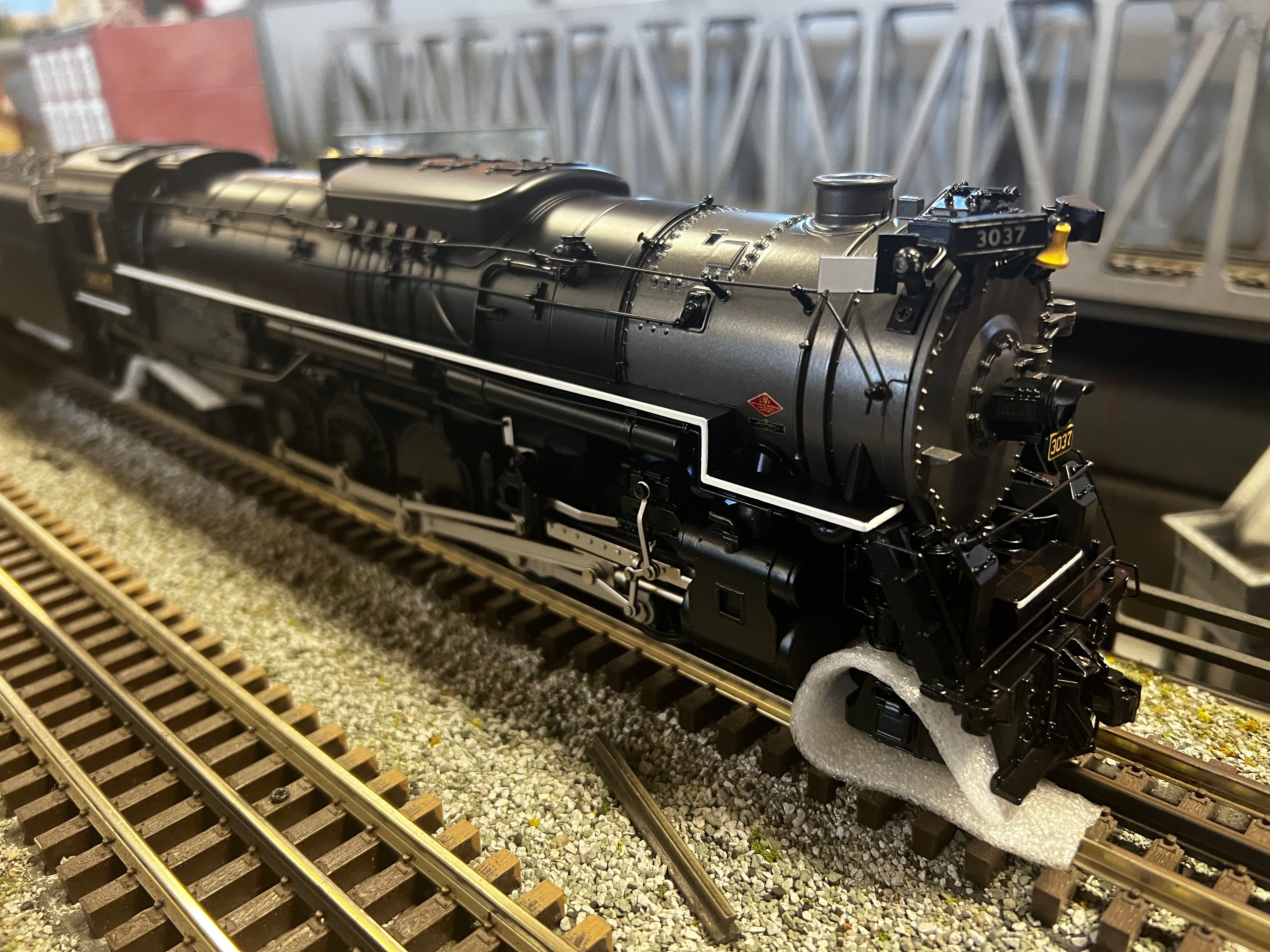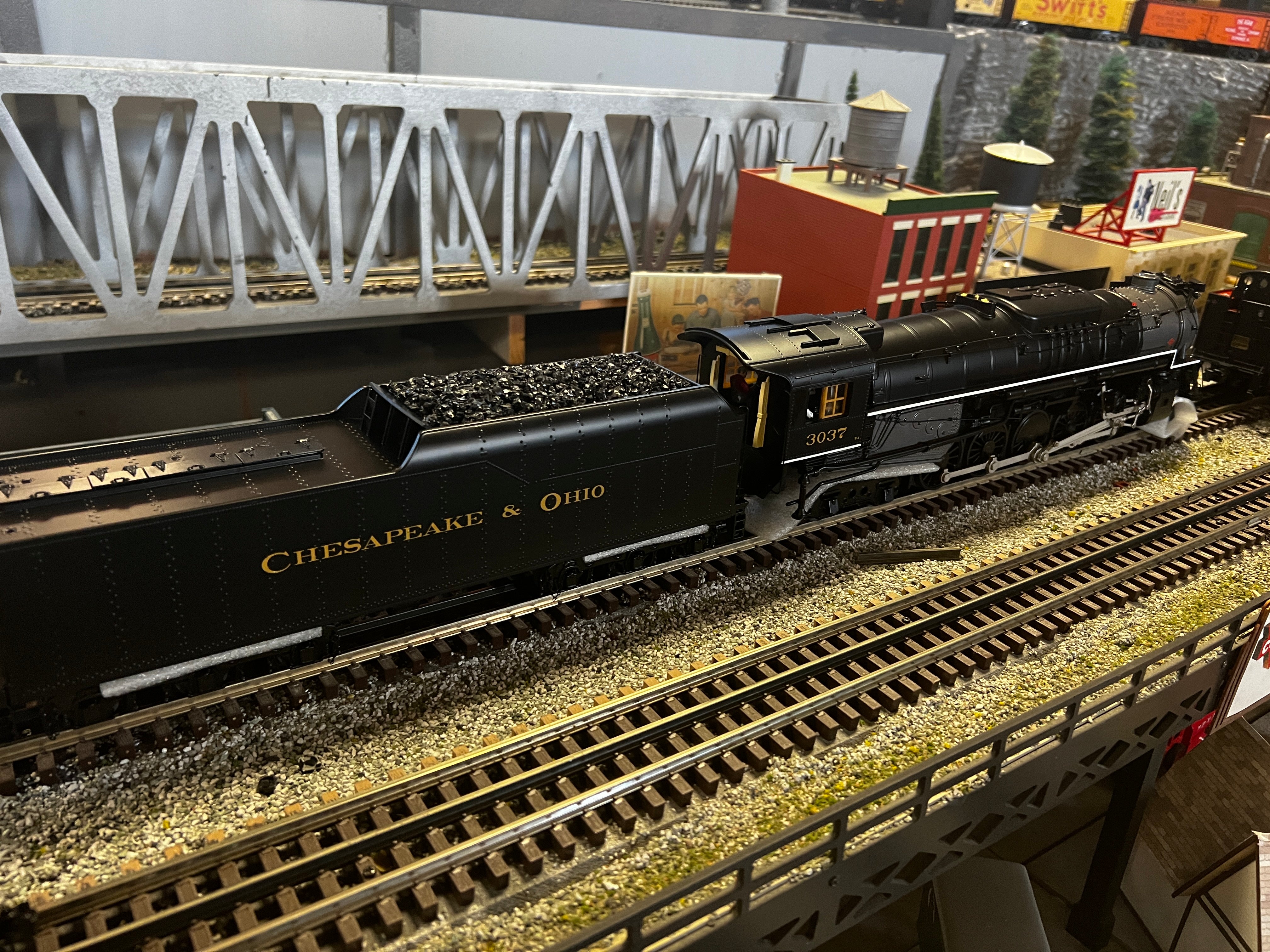Resources
About & Contact Us








MTH 20-3851-1 - T1 2-10-4 Steam Engine "Chesapeake & Ohio" #3037 w/ PS3
- Sale price
- $ 1,099.95
- Regular price
- $ 1,399.95
- You save
- $ 300.00 (22%)
Product Information
| Announced Date: | May 2022 |
| Released Date: | Feb 2023 |
| Individually Boxed: | No - 2 to a case |
- Road Name: Chesapeake & Ohio
- Road Number: 3037
- Product Line: Premier
- Scale: O Scale
Features:
- Intricately Detailed, Die-Cast Boiler and Chassis
- Intricately Detailed, Die-Cast Tender Body
- Authentic Paint Scheme
- Real Tender Coal Load
- Die-Cast Locomotive Trucks
- Handpainted Engineer and Fireman Figures
- Painted Cab Backhead Gauges
- Legible Builders Plates
- Metal Handrails, Whiste and Bell
- Tender Truck Chains
- Scale Operating Kadee-Compatible Coupler
- Remote-Controlled Proto-Coupler
- O Scale Kadee-Compatible Coupler Mounting Pads
- Prototypical Rule 17 Lighting
- Constant Voltage LED Headlight
- Operating LED Firebox Glow
- Operating LED Marker Lights
- Operating LED Numberboard Lights
- Lighted LED Cab Interior
- Operating Tender LED Back-up Light
- Powerful 5-Pole Precision Flywheel-Equipped Skew-Wound Motor
- Synchronized Puffing ProtoSmoke System
- Locomotive Speed Control In Scale MPH Increments
- Wireless Drawbar
- 1:48 Scale Dimensions
- Onboard DCC/DCS Decoder
- Proto-Sound 3.0 With The Digital Command System Featuring Quillable Whistle With Freight Yard Proto-Effects
- Unit Measures: 30 ½" x 4 ¼" x 2 ¾"
- Operates On O-72 Curves Steam DCC Features
- Headlight on/off
- Bell on/off
- Whistle/Horn on/off
- Start-up/Shut-down
- PFA initiate and advance
- Cab Light on/off
- Engine Sounds on/off
- Volume low, med, high, off
- Smoke on/off
- Forward Signal Sound
- Reverse Signal Sound
- Coupler Slack Sound
- Grade Crossing
- One-Shot Doppler on/off
- Extended Start Up
- Extended Shut Down
- Labor Chuff
- Drift Chuff
- Smoke Volume
- Single short whistle toot
- Coupler Close
- Feature Reset
- Idle Sequence 1
- Idle Sequence 2
- Idle Sequence 3
- Idle Sequence 4
- Brakes auto/off
- Cab Chatter auto/off
- Clickety-Clack auto/off
- F0 Head/Tail light
- F1 Bell
- F2 Horn
- F3 Start-up/Shut-down
- F4 PFA
- F5 Lights (except head/tail)
- F6 Master Volume
- F7 Steaming Whistle
- F8 Rear Coupler
- F9 Forward Signal
- F10 Reverse Signal
- F11 Grade Crossing
- F12 Smoke On/Off
- F13 Smoke Volume
- F14 Idle Sequence 3
- F15 Idle Sequence 2
- F16 Idle Sequence 1
- F17 Extended Start-up
- F18 Extended Shut-down
- F19 Labor Chuff
- F20 Drift Chuff
- F21 One Shot Doppler
- F22 Coupler Slack
- F23 Coupler Close
- F24 Single Horn Blast
- F25 Engine Sounds
- F26 Brake Sounds
- F27 Cab Chatter
- F28 Feature Reset
Overview:
The J1 was the Pennsy's War Baby, conceived and born to move freight for World War II. Like most American railroads, the Pennsylvania found itself short of motive power when traffic ramped up for the war. The Pennsy would have preferred to design its own modern steam loco, but the War Production Board declared otherwise. Only existing, proven designs would be authorized for wartime construction. In retrospect, that was probably a good thing, because none of the Pennsy's postwar steam designs came close to the success of the J1.
For its war baby, the Pennsylvania chose a design created twelve years earlier by Lima for the Chesapeake & Ohio. The C&O T1 2-10-4 possessed the key attribute of a modern "super-power" locomotive: power at speed. Home-built in the Juniata shops from 1942 to 1944, the Pennsy's 125 copies, designated classes J1 and J1a, were quickly recognized by Pennsy faithful as among of the best steamers produced in the modern era. They were at home anywhere west of Altoona, pounding up heavy grades or flying along level stretches. Being based on another road's design, they possessed two distinctively un-Pennsy features - a booster engine and a radial-stay rather than Belpaire firebox. However, their builders managed to give the J's a look all their own, with a substantial Pennsy cast pilot, streamlined cab windows, and a single massive dome that served as both sandbox and steam dome. Viewed from trackside at speed, the J's were the epitome of high, wide, and handsome.
For 2022, the legendary 2-10-4 Texas locomotives return to the M.T.H. Premier lineup. Outfitted with Proto-Sound 3.0.
Did you know?
In the summer of 1956, a motive power shortage led the Pennsy to lease a dozen of the Santa Fe's 5000-series 2-10-4s. The huge oil burners were put to work hauling coal from Columbus to Sandusky, Ohio. Pennsy crews liked them for their easy steaming and good riding qualities.
We Accept
Recommended for You
Browsing history
- Choosing a selection results in a full page refresh.
Get in touch
177 W Main St
Atlanta, IN 46031
765-292-2022
support@mrmuffinstrains.com
Keep in Touch
Sign up for our newsletter and be the first to know about coupons and special promotions.
Country/region
© 2025, MrMuffin'sTrains Powered by Shopify
